
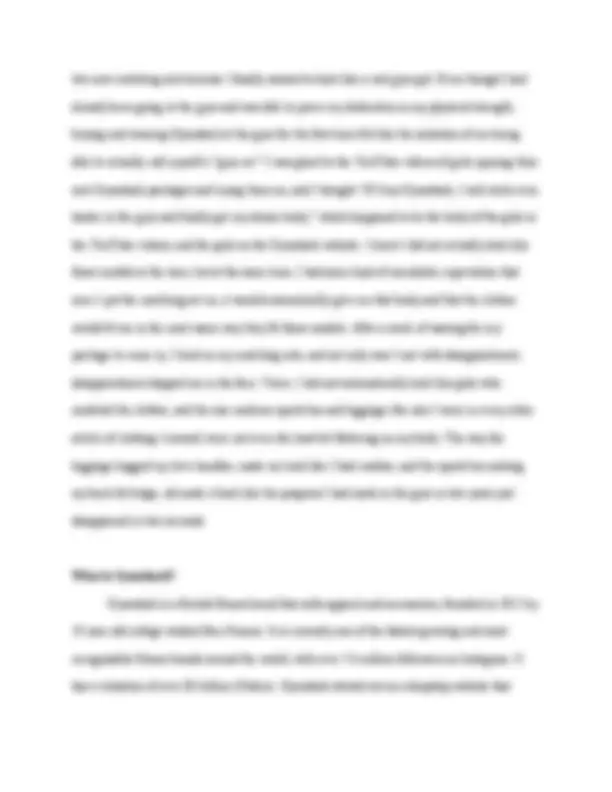
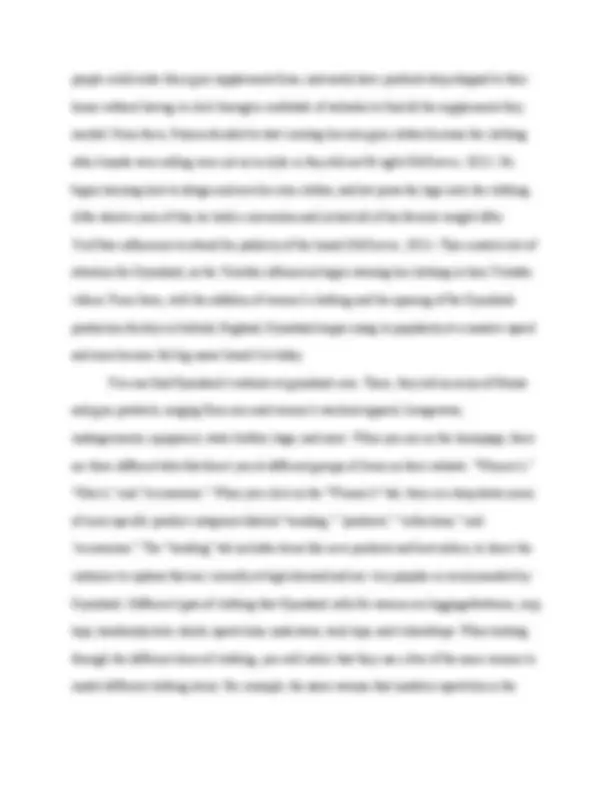
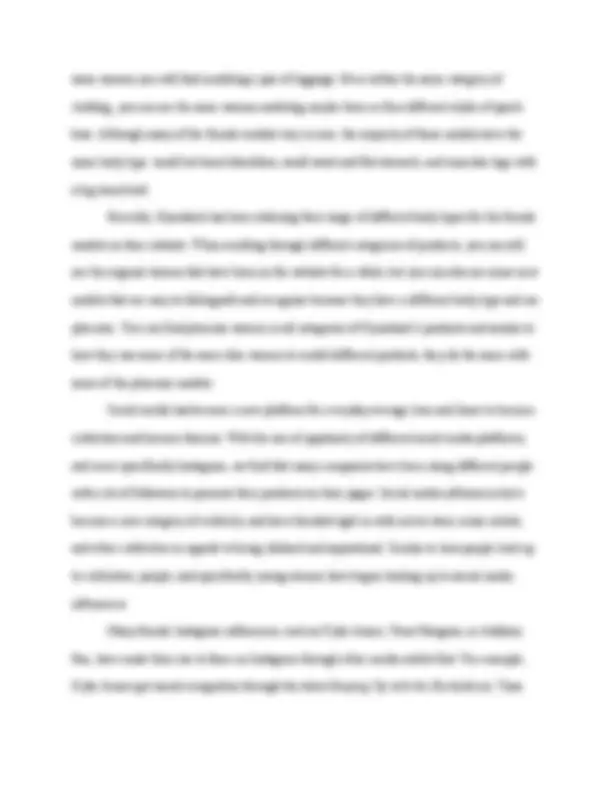
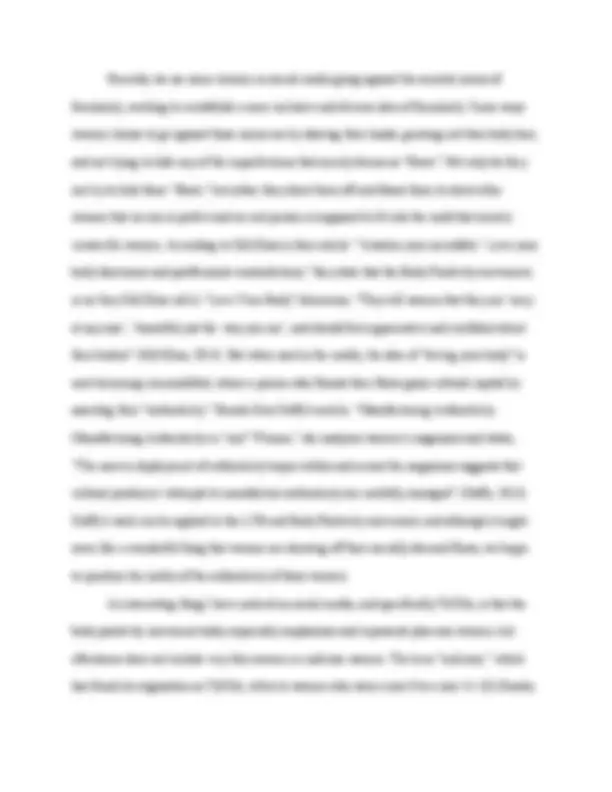
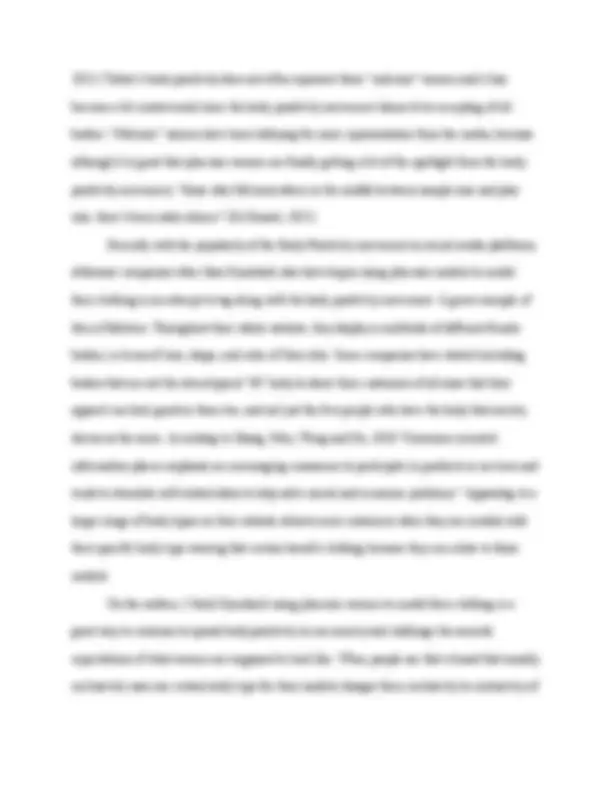
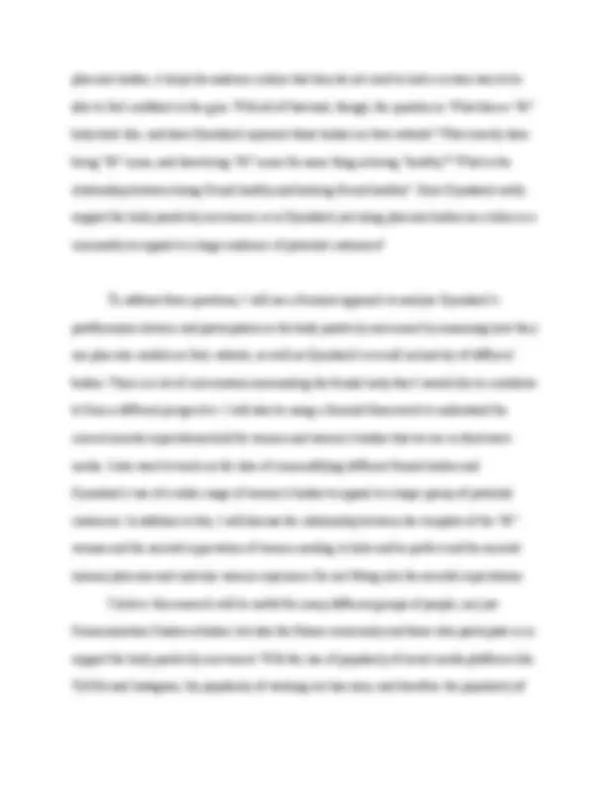
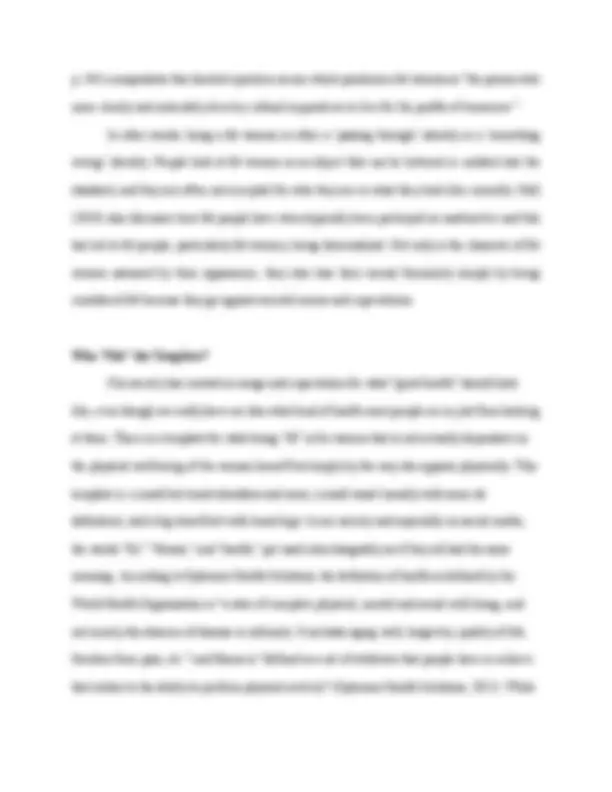
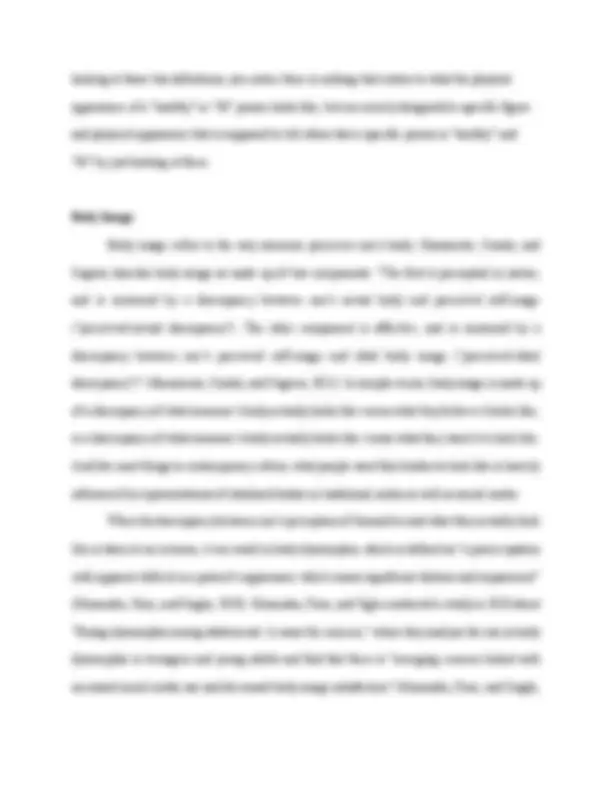
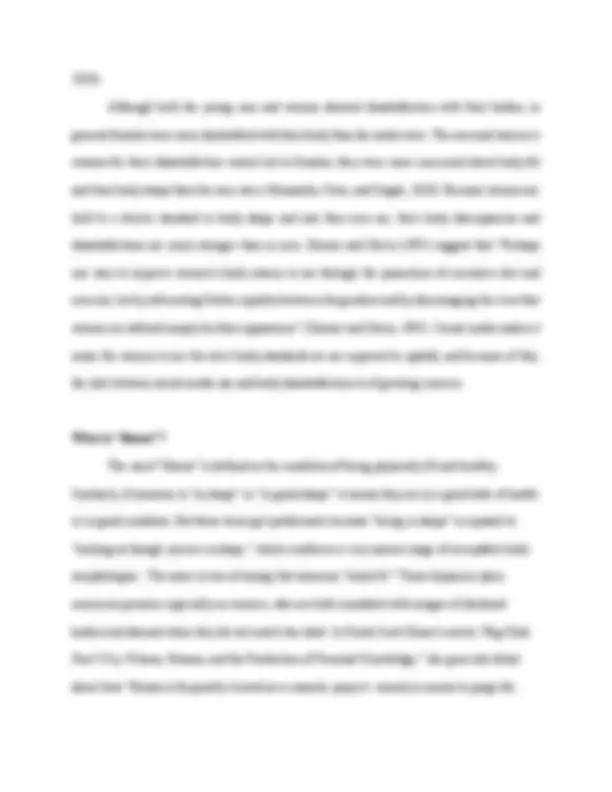
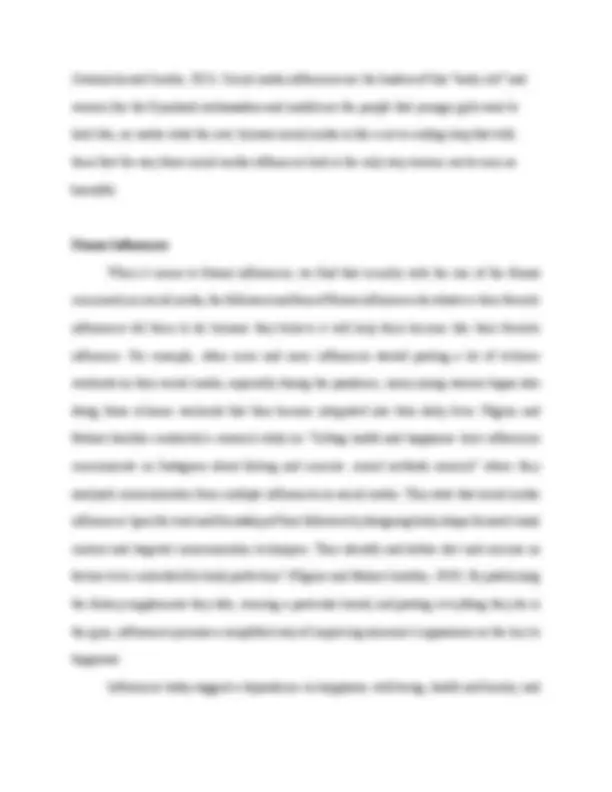
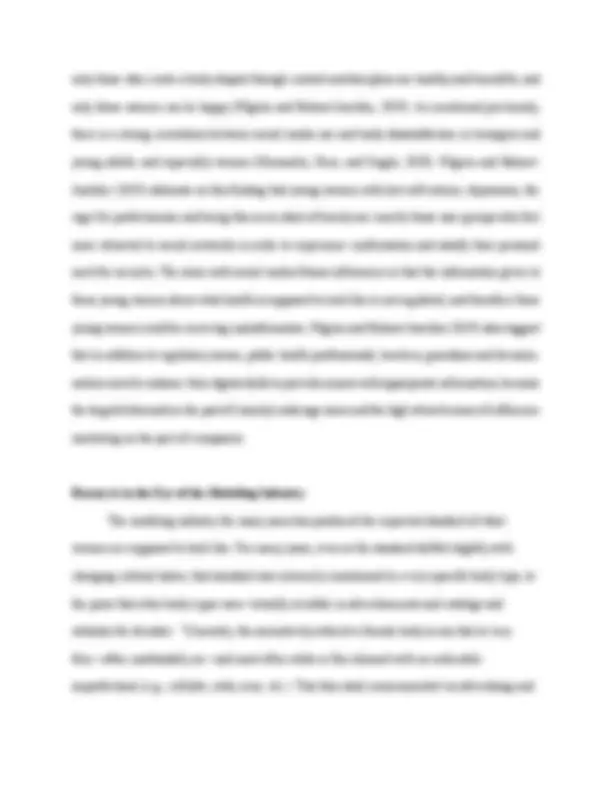
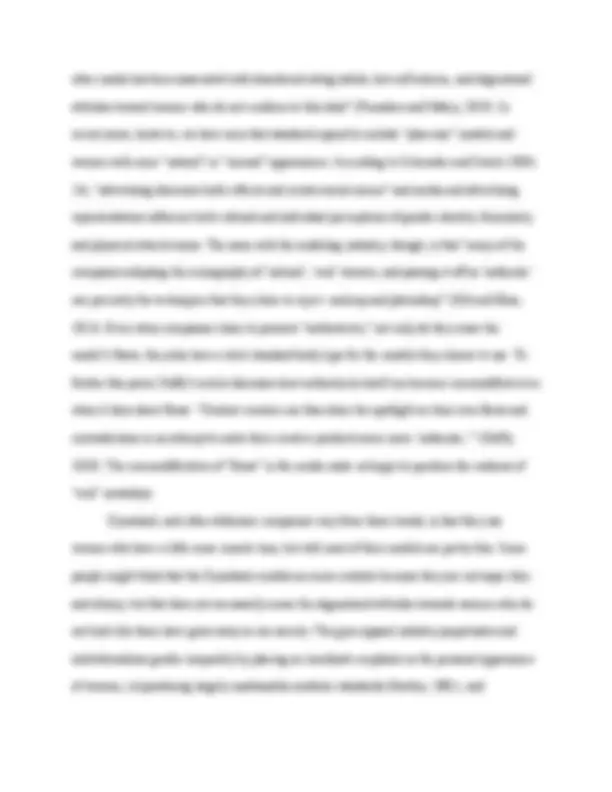
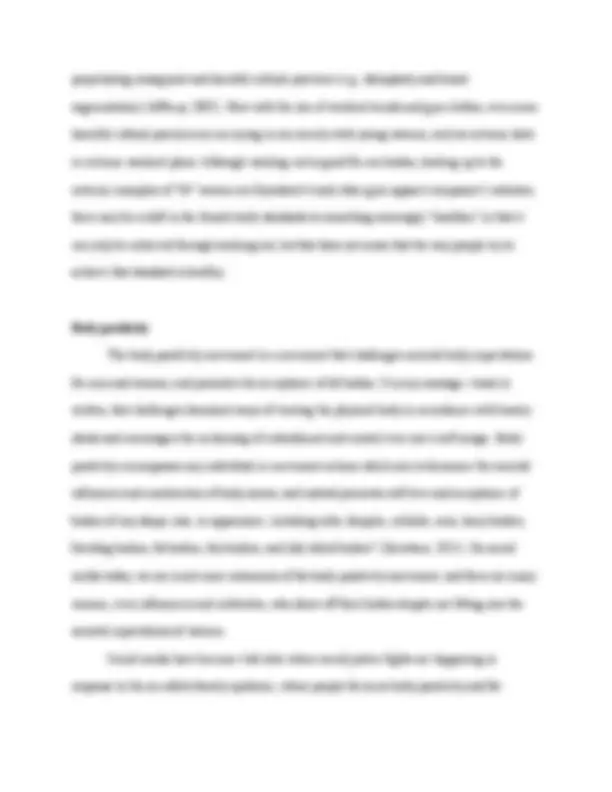
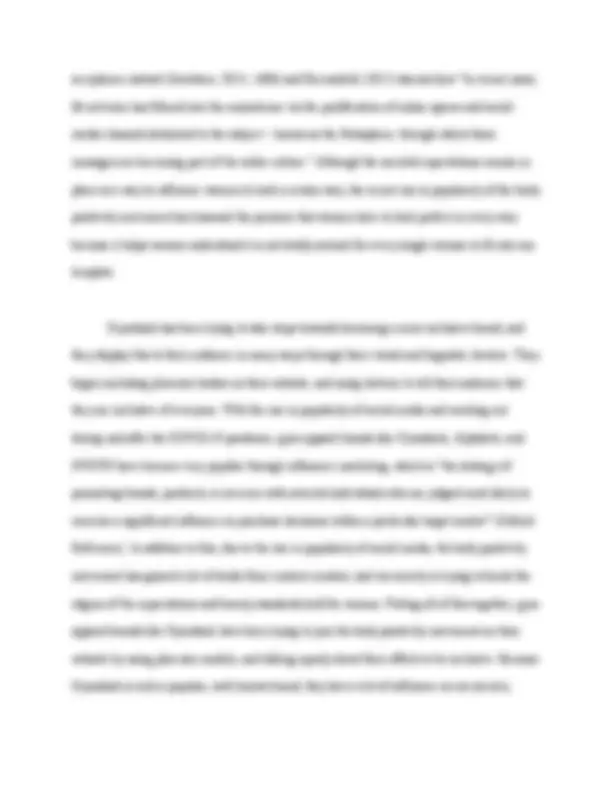
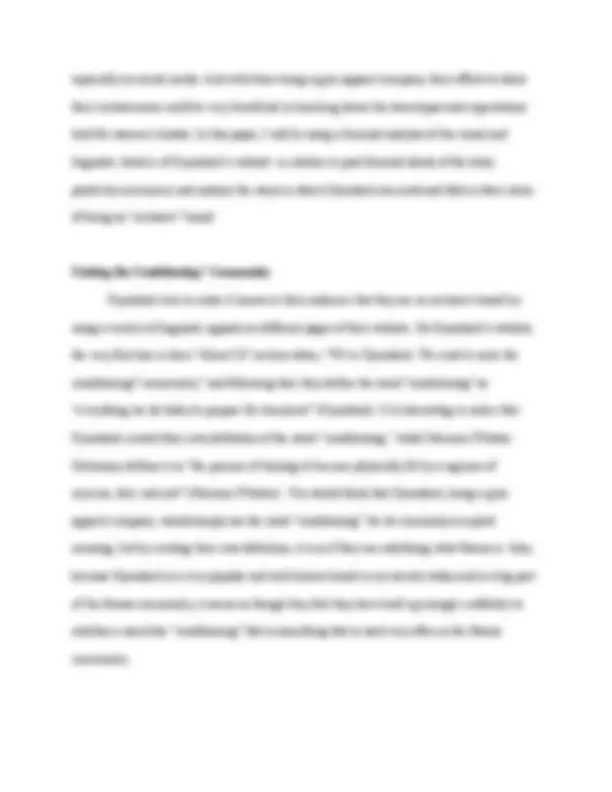
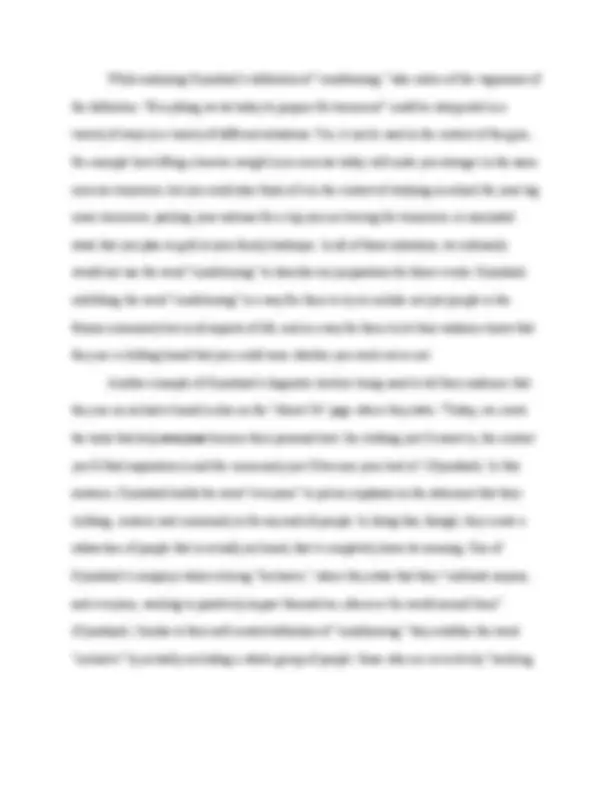
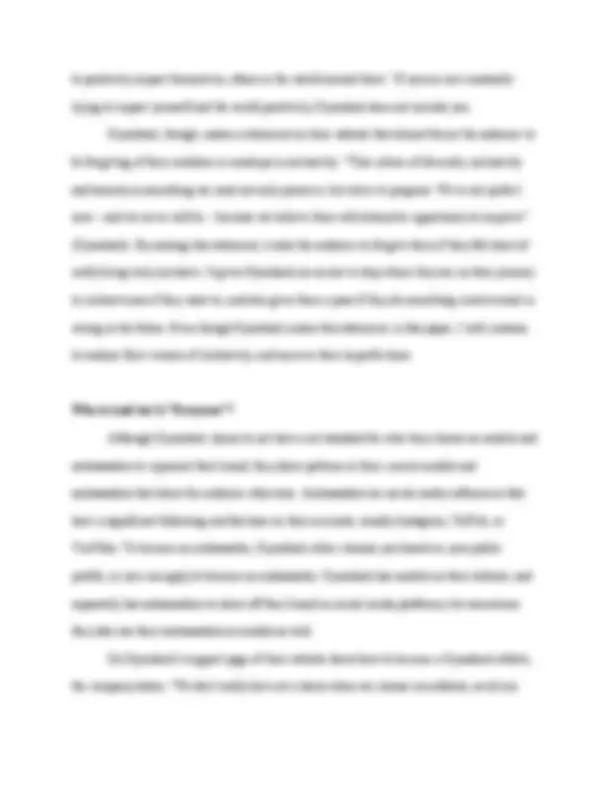
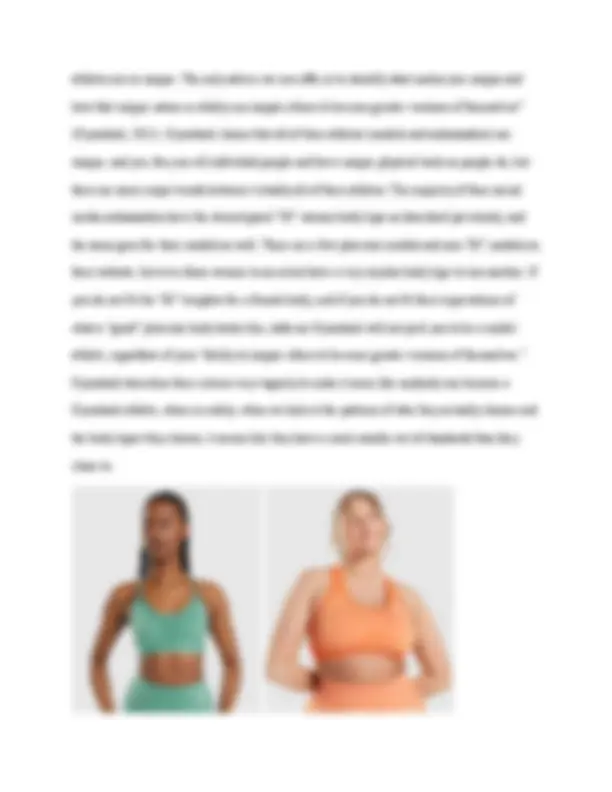
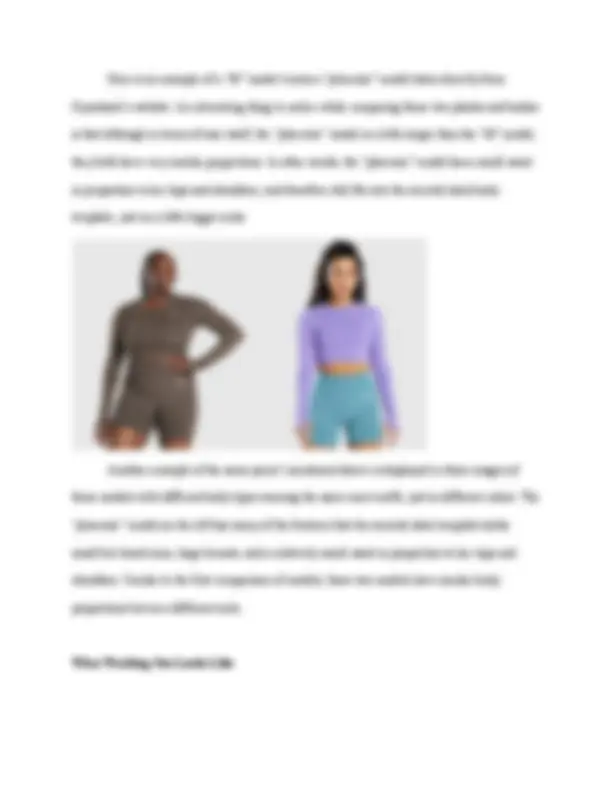
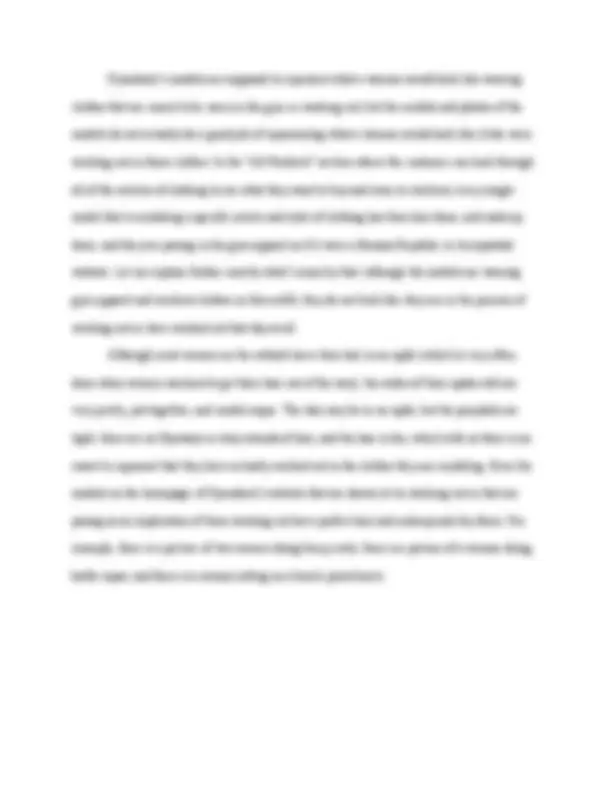
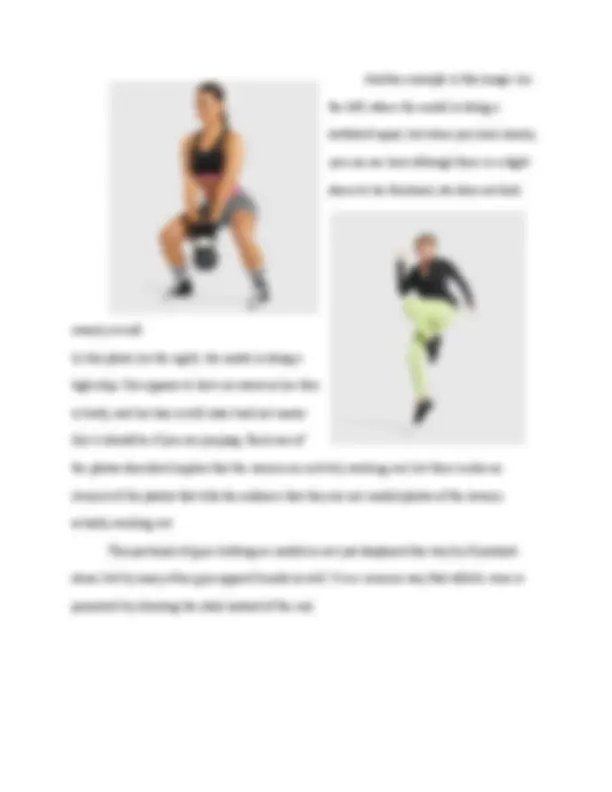
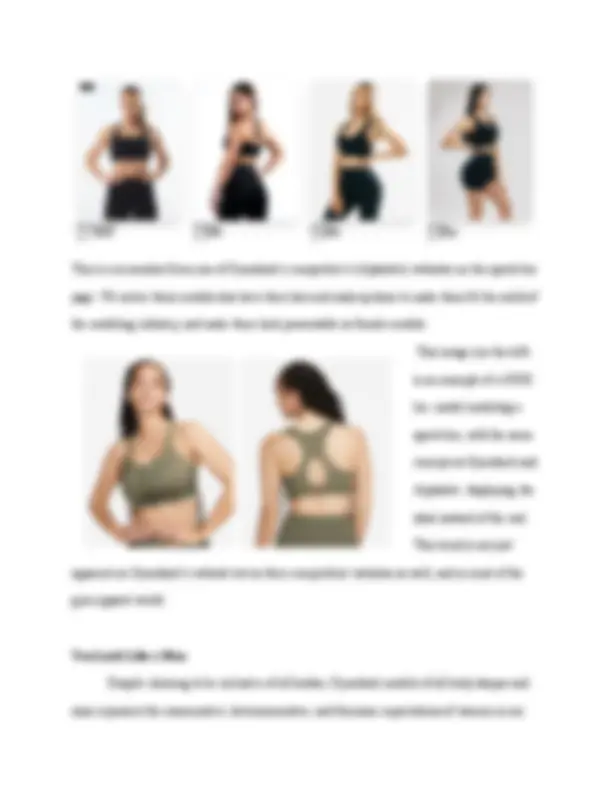
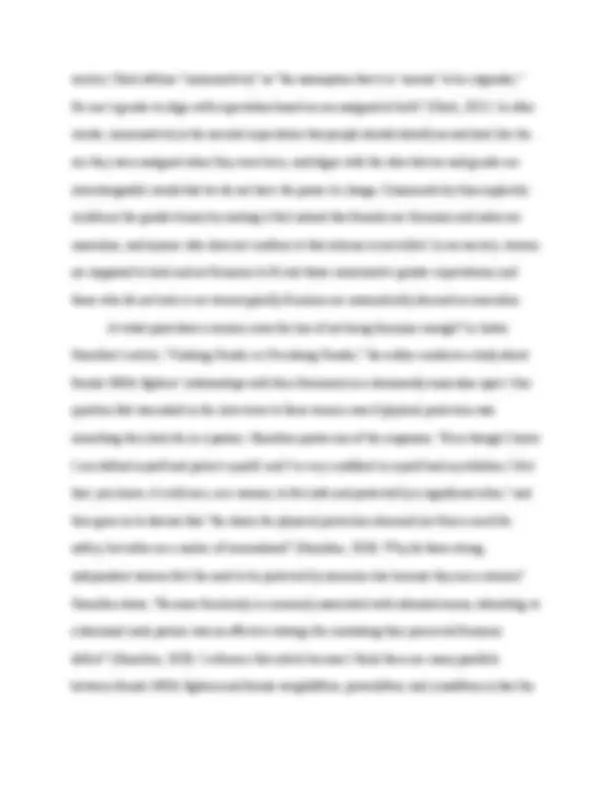
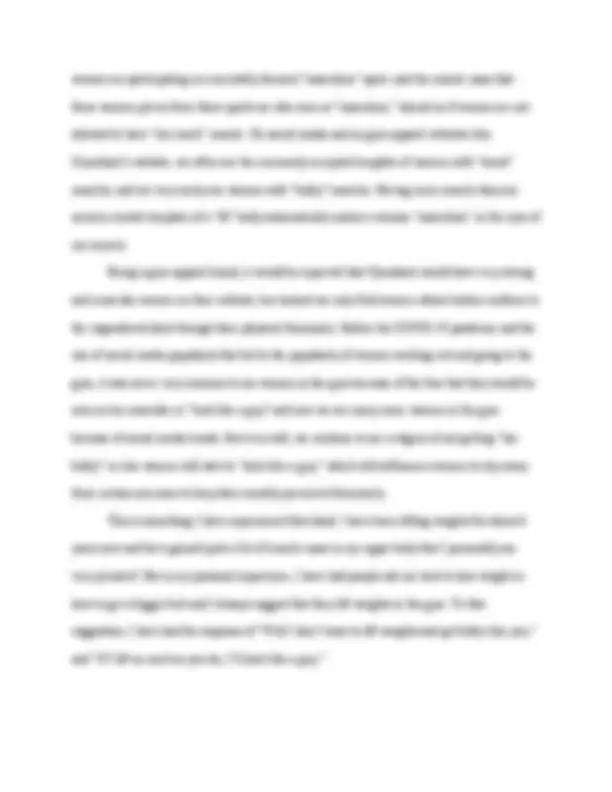
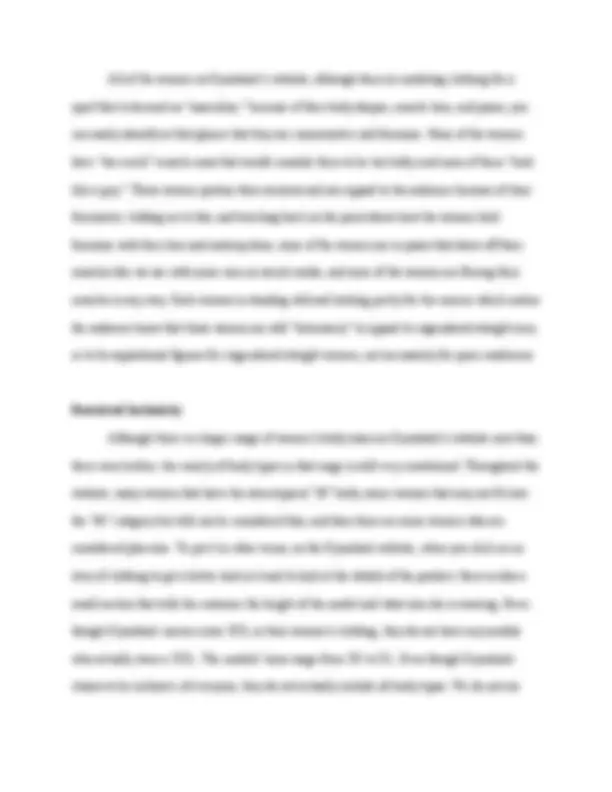
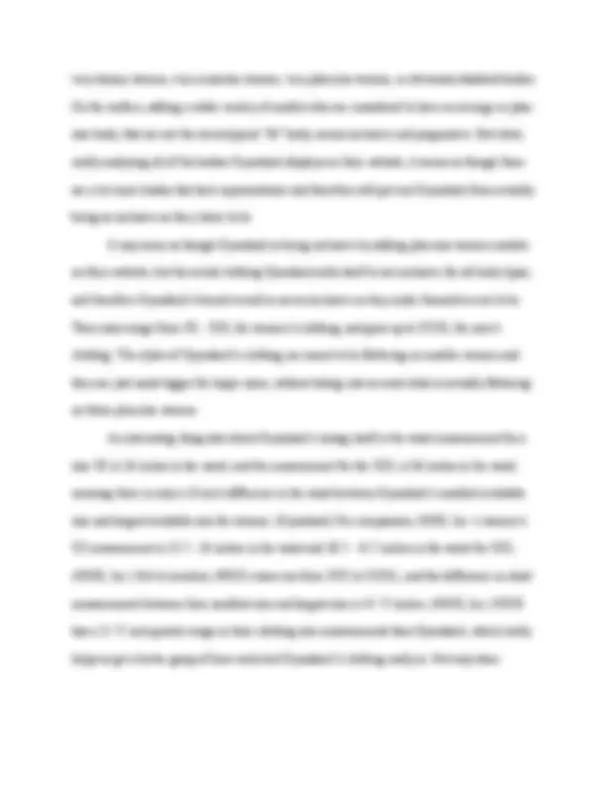
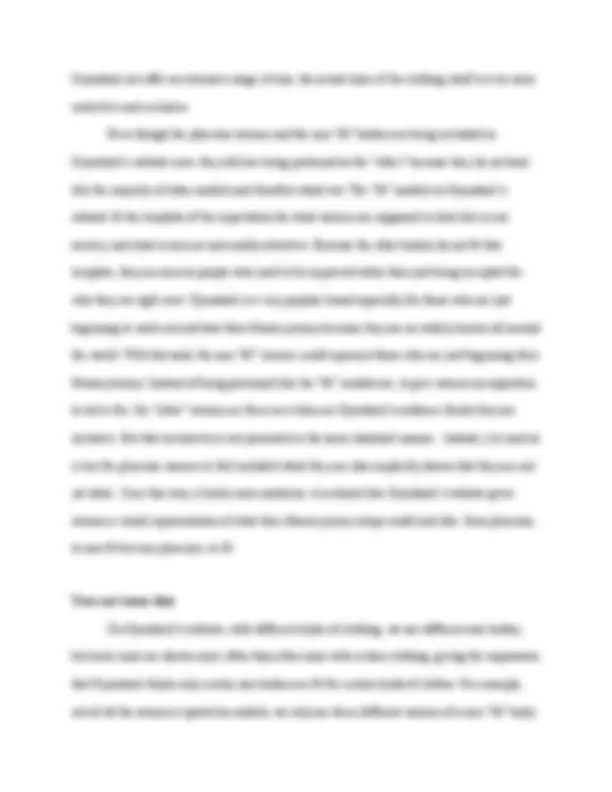
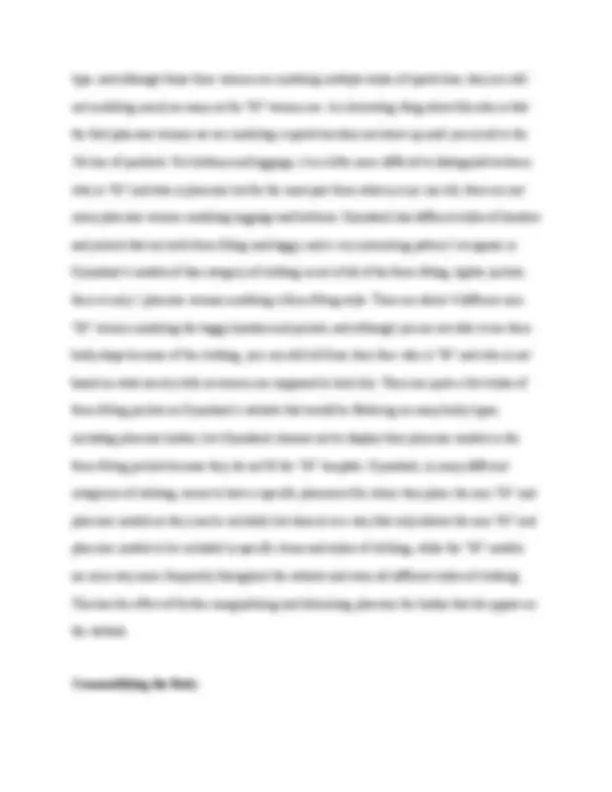
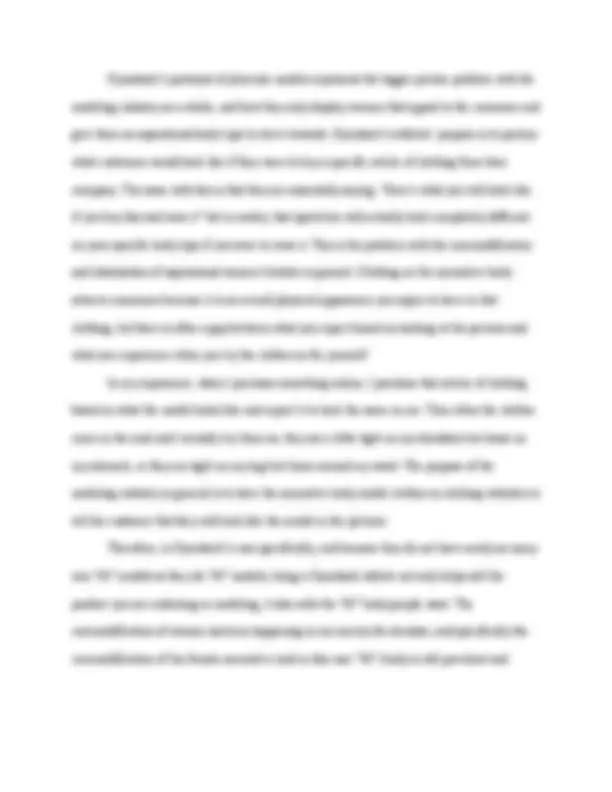
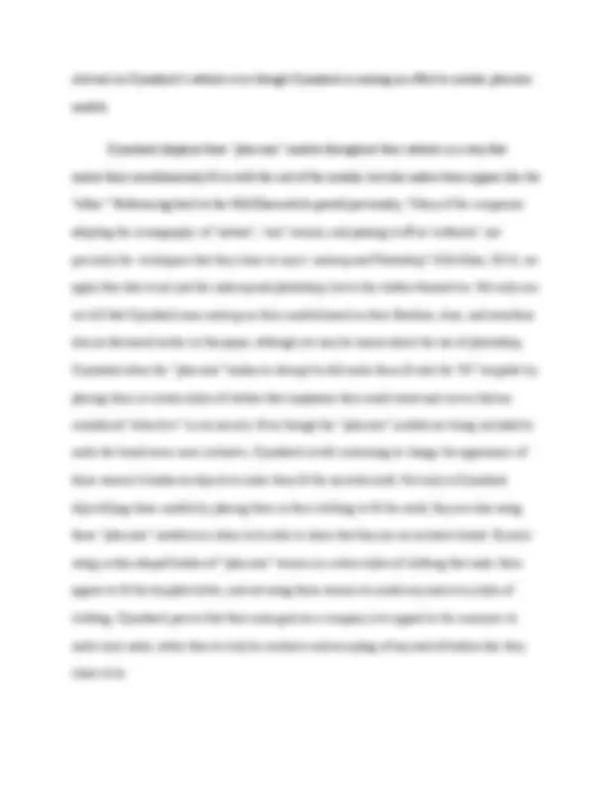
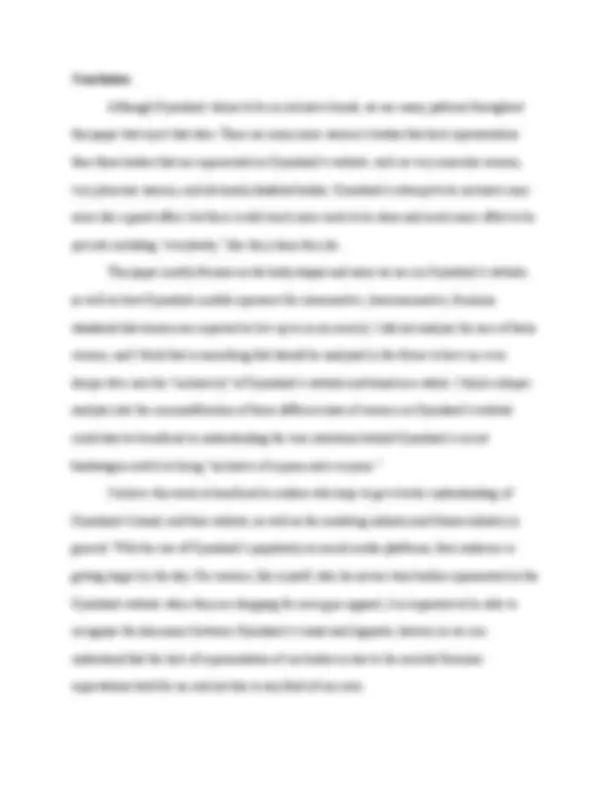


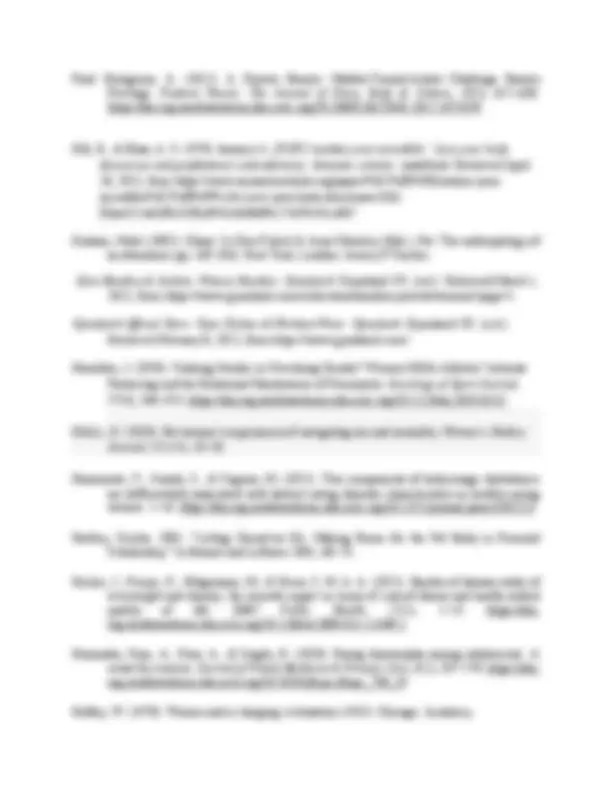





Study with the several resources on Docsity

Earn points by helping other students or get them with a premium plan


Prepare for your exams
Study with the several resources on Docsity

Earn points to download
Earn points by helping other students or get them with a premium plan
Community
Ask the community for help and clear up your study doubts
Discover the best universities in your country according to Docsity users
Free resources
Download our free guides on studying techniques, anxiety management strategies, and thesis advice from Docsity tutors
Becoming an ambassador means you get free products from Gymshark and ... those fitness influencers as brand ambassadors, it influenced even ...
Typology: Exams
1 / 45

This page cannot be seen from the preview
Don't miss anything!






































Who “Fits” the Template?: Unveiling the Restrictions of Inclusivity on Gymshark’s Website Kinly McCaffrey Capstone in Communication Studies Dr. Bob Bednar April 29, 2022
Abstract In this research, my objective is to dive into the recent addition of plus-size women models on the popular gym apparel brand Gymshark’s website and analyze the commodification and tokenization of the plus-size female body particularly on the website. I will be discussing what Gymshark is, how it recently sky-rocketed to popularity, and how it has engaged in being an inclusive brand and participated in the Body Positivity movement. Through the COVID- 19 pandemic, social media platforms have become more popular than ever before, and because of this, the Body Positivity movement, specifically directed towards the female body, has increased awareness, acceptance, and inclusivity of any and all bodies that may not perfectly fall into the 21st century western societal expectations. In communication studies, there have been many recent conversations regarding inclusivity of all bodies, and the Body Positivity movement and, conversely, about the negative stigma surrounding plus-size women. I will be discussing inclusivity and body positivity in relation to post-feminism to show how Gymshark, although claims to be inclusive of everyone, has many flaws in the linguistic and visual rhetoric on their website that does not support their claim of inclusivity. Introduction I was 18 years old in 2018 when I ordered my first matching workout set from Gymshark, and not only did I order one set, I ordered two: a dark pink set of matching leggings and a sports bra, and a blue-gray set of matching leggings and a sports bra. At that point I had been lifting for about two years, but as a high school student, although the outfits were cute, Gymshark was not the most affordable and practical option to wear in the gym at the time. I remember saving up half of my paycheck from my job at Coldstone Creamery to spend on these
people could order their gym supplements from, and easily have products drop shipped to their house without having to click through a multitude of websites to find all the supplements they needed. From there, Francis decided to start creating his own gym clothes because the clothing other brands were selling were not as in-style or they did not fit right (McKeever, 2021). He began learning how to design and sew his own clothes, and hot press the logo onto the clothing. After about a year of this, he held a convention and invited all of his favorite weight-lifter YouTube influencers to attend for publicity of the brand (McKeever, 2021). This created a lot of attention for Gymshark, as the Youtube influencers began wearing his clothing in their Youtube videos. From there, with the addition of women’s clothing and the opening of the Gymshark production facility in Solihull, England, Gymshark began rising to popularity at a massive speed and soon became the big-name brand it is today. You can find Gymshark’s website at gymshark.com. There, they sell an array of fitness and gym products, ranging from men and women’s workout apparel, loungewear, undergarments, equipment, water bottles, bags, and more. When you are on the homepage, there are three different tabs that direct you to different groups of items on their website: “Women’s,” “Men’s,” and “Accessories.” When you click on the “Women’s” tab, there is a drop down menu of more specific product categories labeled “trending,” “products,” “collections,” and “accessories.” The “trending” tab includes items like new products and best sellers, to direct the customer to options that are currently at high demand and are very popular or recommended by Gymshark. Different types of clothing that Gymshark sells for women are leggings/bottoms, crop tops, hoodies/jackets, shorts, sports bras, underwear, tank tops, and t-shirts/tops. When looking through the different items of clothing, you will notice that they use a few of the same women to model different clothing items. For example, the same woman that models a sports bra is the
same woman you will find modeling a pair of leggings. Even within the same category of clothing, you can see the same woman modeling maybe three or four different styles of sports bras. Although many of the female models vary in race, the majority of these models have the same body type: small but toned shoulders, small waist and flat stomach, and muscular legs with a big toned butt. Recently, Gymshark has been widening their range of different body types for the female models on their website. When scrolling through different categories of products, you can still see the original women that have been on the website for a while, but you can also see some new models that are easy to distinguish and recognize because they have a different body type and are plus-size. You can find plus-size women in all categories of Gymshark’s products and similar to how they use some of the same slim women to model different products, they do the same with some of the plus-size models. Social media has become a new platform for everyday average Joes and Janes to become celebrities and become famous. With the rise of popularity of different social media platforms, and more specifically Instagram, we find that many companies have been using different people with a lot of followers to promote their products on their pages. Social media influencers have become a new category of celebrity, and have blended right in with movie stars, music artists, and other celebrities in regards to being idolized and aspirational. Similar to how people look up to celebrities, people, and specifically young women have begun looking up to social media influencers. Many female Instagram influencers, such as Kylie Jenner, Tana Mongeau, or Addison Rae, have made their rise to fame on Instagram through other media outlets first. For example, Kylie Jenner got social recognition through the show Keeping Up with the Kardashians. Tana
Power, NVGTN, and Alphalete, began picking out those fitness influencers to become ambassadors for their brand. And as you can probably guess, because people started noticing those fitness influencers as brand ambassadors, it influenced even more people to become fitness influencers. And it has now just become one big cycle that all began with Gymshark. The Body Positivity movement is a movement that challenges the societal expectations that women and men are supposed to look a certain way by critiquing established body image ideals while encouraging people to love the body they are in. Journalist Kendra Cherry describes it as “the assertion that all people deserve to have a positive body image, regardless of how society and popular culture view ideal shape, size, and appearance” (Cherry, 2020). It also promotes the acceptance of all bodies, helps people build confidence in their bodies the way they are, and addresses and exposes unrealistic body standards. Not only does it acknowledge and challenge how society views people based on their physical size and shape, but also recognizes race, gender, sexuality, and disability. It aims to help people understand that the media portrays bodies in a way that they think is attractive by photoshopping women’s bodies and removing all blemishes and “flaws.” By exposing the way the media alters real bodies, it aims to help people have a healthier and more realistic relationship with their bodies, including how they feel about food, exercise, clothes, health, and identity. The body positivity movement in our current society has become very popular, particularly with Gen Z, and social media platforms like TikTok help spread acceptance of all bodies, and especially plus-size bodies, that may not fit into the template of what women are expected to look like. Many content creators have begun sharing their bodies without shame and with confidence to help others understand that everyone should be happy in the skin they are in.
Recently we see some women on social media going against the societal norms of femininity, working to reestablish a more inclusive and diverse idea of femininity. Some ways women choose to go against these norms are by shaving their heads, growing out their body hair, and not trying to hide any of the imperfections that society deems as “flaws.” Not only do they not try to hide these “flaws,” but rather they show them off and flaunt them to show other women that no one is perfect and no real person is supposed to fit into the mold that society creates for women. According to Gill-Elias in their article “‘Awaken your incredible’: Love your body discourses and postfeminist contradictions,” they state that the Body Positivity movement, or as they Gill-Elias call it, “Love Your Body” discourses, “They tell women that they are ‘sexy at any size’, ‘beautiful just the way you are’, and should feel appreciative and confident about their bodies” (Gill-Elias, 2014). But when used in the media, the idea of “loving your body” is now becoming commodified, where a person who flaunts their flaws gains cultural capital by asserting their “authenticity.” Brooke Erin Duffy’s article, “Manufacturing Authenticity: Manufacturing Authenticity in “real” Women,” she analyzes women’s magazines and states, “The uneven deployment of authenticity tropes within and across the magazines suggests that cultural producers’ attempts to manufacture authenticity are carefully managed” (Duffy, 2013). Duffy’s work can be applied to the LYB and Body Positivity movement, and although it might seem like a wonderful thing that women are showing off their socially deemed flaws, we begin to question the reality of the authenticity of these women. An interesting thing I have noticed on social media, and specifically TikTok, is that the body positivity movement today especially emphasizes and represents plus-size women, but oftentimes does not include very thin women or mid-size women. The term “mid-size,” which has found its origination on TikTok, refers to women who wear a size 8 to a size 14. (Di Donato,
plus-size bodies, it helps the audience realize that they do not need to look a certain way to be able to feel confident in the gym. With all of that said, though, the question is: What does a “fit” body look like, and does Gymshark represent those bodies on their website? What exactly does being “fit” mean, and does being “fit” mean the same thing as being “healthy”? What is the relationship between being fit and healthy and looking fit and healthy? Does Gymshark really support the body positivity movement, or is Gymshark just using plus-size bodies as a token or a commodity to appeal to a larger audience of potential customers? To address these questions, I will use a feminist approach to analyze Gymshark’s postfeminism rhetoric and participation in the body positivity movement by examining how they use plus-size models on their website, as well as Gymshark’s overall inclusivity of different bodies. There is a lot of conversation surrounding the female body that I would like to contribute to from a different perspective. I will also be using a feminist framework to understand the current societal expectations held for women and women’s bodies that we see in third-wave media. I also want to touch on the idea of commodifying different female bodies and Gymshark’s use of a wider range of women’s bodies to appeal to a larger group of potential customers. In addition to this, I will discuss the relationship between the template of the “fit” woman and the societal expectation of women needing to look and be perfect and the societal tyranny plus-size and mid-size women experience for not fitting into the societal expectations. I believe this research will be useful for many different groups of people, not just Communication Studies scholars, but also the fitness community and those who participate in or support the body positivity movement. With the rise of popularity of social media platforms like TikTok and Instagram, the popularity of working out has risen, and therefore the popularity of
gym apparel has risen as well in our society on social media. I think analyzing Gymshark’s choices of female models in an attempt to be inclusive is very important in our current society, as well as uncovering whether or not Gymshark is using plus-size models to really promote body positivity or if they are just commodifying plus-size women to appeal to a larger audience of consumers. In this research, I will be identifying the issues in the lack of inclusivity on Gymshark’s website, despite their claims of being an inclusive community, as well as analyzing the linguistic and visual rhetoric they use in an attempt to be inclusive, and emphasize where they fail to truly be inclusive of all bodies. Fat People and Fat Women The definitions of the words “fat,” “obese,” and “overweight” are all very commonly mixed up and misused when describing an individual’s outward appearance of state of well-being and health, but every one of those words is used in a negative or condescending way towards people who do not fit the societal norm. For example the word “fat” is an adjective that is used to describe someone’s physical appearance, where the words “obese” and “overweight” are used to describe the state of having a higher than average body mass index (BMI): “overweight (defined as body mass index (BMI) ≥ 25 kg/m2 ) and obesity (defined as BMI ≥ 30 kg/m2 ) among adults aged 18 years and older,” (Hecker, Freijer, Hiligsmann, and Evers, 2022). The word “fat” according to Hall “does not denote a medical condition or suggest
p. 341) encapsulates this limited repertoire as one which positions a fat woman as “the person who more clearly and noticeably lives by cultural imperatives to live for the profits of tomorrow.” In other words, being a fat woman is either a ‘passing through’ identity or a ‘something wrong’ identity. People look at fat women as an object that can be bettered or molded into the standard, and they are often not accepted for who they are or what they look like currently. Hall (2018) also discusses how fat people have stereotypically been portrayed as unattractive and this has led to fat people, particularly fat women, being desexualized. Not only is the character of fat women assumed by their appearance, they also lose their sexual femininity simply by being considered fat because they go against societal norms and expectations. Who “Fits” the Template? Our society has created an image and expectation for what “good health” should look like, even though we really have no idea what kind of health most people are in just from looking at them. There is a template for what being “fit” is for women that is not actually dependent on the physical well-being of the woman herself but simply by the way she appears physically. This template is: a small but toned shoulders and arms, a small waist (usually with some ab definition), and a big toned butt with toned legs. In our society and especially on social media, the words “fit,” “fitness,” and “health,” get used interchangeably as if they all had the same meaning. According to Optimum Health Solutions, the definition of health as defined by the World Health Organization is “a state of complete physical, mental and social well-being, and not merely the absence of disease or infirmity. It includes aging well, longevity, quality of life, freedom from pain, etc.” and fitness is “defined as a set of attributes that people have or achieve that relates to the ability to perform physical activity” (Optimum Health Solutions, 2015). While
looking at these two definitions, you notice there is nothing that relates to what the physical appearance of a “healthy” or “fit” person looks like, but our society designated a specific figure and physical appearance that is supposed to tell others that a specific person is “healthy” and “fit” by just looking at them. Body Image Body image refers to the way someone perceives one’s body. Hamamoto, Suzuki, and Sugiera describe body image as made up of two components: “The first is perceptual in nature, and is measured by a discrepancy between one’s actual body and perceived self-image (“perceived–actual discrepancy”). The other component is affective, and is measured by a discrepancy between one’s perceived self-image and ideal body image (“perceived–ideal discrepancy”)” (Hamamoto, Suzuki, and Sugiera, 2022). In simpler terms, body image is made up of a discrepancy of what someone’s body actually looks like versus what they believe it looks like, or a discrepancy of what someone’s body actually looks like versus what they want it to look like. And like most things in contemporary culture, what people want their bodies to look like is heavily influenced by representations of idealized bodies in traditional media as well as social media. When the discrepancy between one’s perception of themselves and what they actually look like is taken to an extreme, it can result in body dysmorphia, which is defined as “a preoccupation with apparent defects in a patient’s appearance which causes significant distress and impairment” (Himanshu, Kaur, and Singla, 2020). Himanshu, Kaur, and Sigla conducted a study in 2020 about “Rising dysmorphia among adolescents: A cause for concern,” where they analyze the rise in body dysmorphia in teenagers and young adults and find that there is “emerging concern linked with increased social media use and decreased body image satisfaction” (Himanshu, Kaur, and Singla,
pursue a generally unattainable thin and youthful aesthetic, and erase or “overcome” any markers of physical debility or difference (including age, ethnically distinct body features, and disabilities), as well as evidence of life experiences such as pregnancy and menopause” (Scott- Dixon, 2008). There is an idea in our society that if a woman can become “fit,” they will have the ability to erase all of their flaws, or things that do not make you look like the 21st century western ideal of a perfect woman. The funny thing is, though, and I use the word “funny” sarcastically, that the things that our society considers flaws in women are really just natural occurring physical aspects that virtually all women obtain in their lifetime, like stretch marks, belly fat, acne, and wrinkles. Social media is an easily accessible way for women to realize that their naturally occurring physicality is flawed, and therefore, according to our current society's template of what it means to be fit, not fit. Katherin Pilgrim and Sabine Bohnet-Joschko discuss how social media influencers have a strong influence on what people think health is in our society: “Building a connection between external beauty and perceived well-being, and thus mental health, is a direct effect of influencers’ health communication” (Pilgrim and Bohnet-Joschko, 2019). Not only does this current societal idea of fitness affect the routines of healthy women with naturally occurring changes in physicality because they begin working out more to fit the template social media tells us is what we are supposed to look like, but attempting to fit into that template even when it is not natural for every specific individual to be able to is very taxing on women’s mental health and never-ending. Social Media Influencers in Third-Wave Media
With the rise of third-wave media in the 21st century, and specifically social media, celebrities are becoming plentiful and more publicly recognized than ever, and now there is a new subcategory of celebrities called “social media influencers” who make a name for themselves simply for their content on social media. SMIs are individuals who, through producing original content that publicly displays their expertise and/or taste, have amassed a large network of followers and are regarded as trusted tastemakers and experts (Scholz, 2021). Given their origins as “ordinary” consumers, influencers are generally conceptualized as similar to everyday consumers and, hence, more authentic than models and celebrities who are traditionally featured in advertising. Bloggers, YouTubers, and “Instafamous” people have been found to outperform their more traditional counterparts (e.g., magazine articles, celebrity endorsers) because consumers feel more closely connected to them and perceive them to be more credible and relatable (Scholz, 2021). In displaying their lives to their hundreds of thousands, and sometimes millions of followers, many people, but specifically women follow them because of their envy of those influencers’ highly curated lives. In Jiyoung Chae’s article “Explaining Females’ Envy Toward Social Media Influencers,” they state, “... influencer postings are the catalogs of what many young people dream of having and the lifestyle they dream of living (Chae, 2018). Social media portrays the best part of people that makes everyone else think that that is their real life. Typically people do not portray their flaws or express their hardships unless it is for a strategic purpose, so it makes followers believe their lives are perfect, and who would not want a perfect life with a perfect body? Iwannicka and Soroka describe social media as promoting “body cult” behaviors: “The goal of the above-mentioned activities is for young women to obtain a slim and attractive figure in line with the trends of female attractiveness proposed by the media”
only those who create a body shaped through control and discipline are healthy and beautiful, and only those women can be happy (Pilgrim and Bohnet-Joschko, 2019). As mentioned previously, there is a strong correlation between social media use and body dissatisfaction in teenagers and young adults, and especially women (Himanshu, Kaur, and Singla, 2020). Pilgrim and Bohnet- Joschko (2019) elaborate on this finding that young women with low self-esteem, depression, the urge for perfectionism and being thin as an ideal of beauty are exactly those user groups who feel more attracted to social networks in order to experience confirmation and satisfy their personal need for security. The issue with social media fitness influencers is that the information given to these young women about what health is supposed to look like is not regulated, and therefore these young women could be receiving misinformation. Pilgrim and Bohnet-Joschko (2019) also suggest that in addition to regulatory issues, public health professionals, teachers, guardians and decision- makers need to enhance their digital skills to provide minors with appropriate information, because the targeted demand on the part of (mainly) underage users and the high attractiveness of influencer marketing on the part of companies. Beauty is in the Eye of the Modeling Industry The modeling industry for many years has produced the expected standard of what women are supposed to look like. For many years, even as the standard shifted slightly with changing cultural tastes, that standard was extremely constrained to a very specific body type, to the point that other body types were virtually invisible in advertisements and catalogs and websites for decades. “Currently, the normatively attractive female body is one that is very thin—often unattainably so—and most often white or fair-skinned with no noticeable imperfections (e.g., cellulite, rolls, acne, etc.). This thin-ideal communicated via advertising and
other media has been associated with disordered eating habits, low self-esteem, and stigmatized attitudes toward women who do not conform to this ideal” (Pounders and Mabry, 2019). In recent years, however, we have seen that standard expand to include “plus-size” models and women with more “natural” or “normal” appearances. According to Schroeder and Zwick (2004, 24), “advertising discourse both reflects and creates social norms” and media and advertising representations influence both cultural and individual perceptions of gender identity, femininity, and physical attractiveness. The issue with the modeling industry, though, is that “many of the companies adopting the iconography of ‘natural’, ‘real’ women, and passing it off as ‘authentic’ use precisely the techniques that they claim to reject: makeup and photoshop” (Gill and Elias, 2014). Even when companies claim to promote “authenticity,” not only do they erase the model’s flaws, they also have a strict standard body type for the models they choose to use. To further this point, Duffy’s article discusses how authenticity itself can become commodified even when it does show flaws: “Content creators can thus shine the spotlight on their own flaws and contradictions in an attempt to make their creative products seem more ‘authentic,’” (Duffy, 2020). The commodification of “flaws” in the media make us begin to question the realness of “real” nowadays. Gymshark, and other athleisure companies vary from these trends, in that they use women who have a little more muscle tone, but still most of their models are pretty thin. Some people might think that the Gymshark models are more realistic because they are not super thin and skinny, but that does not necessarily mean the stigmatized attitudes towards women who do not look like them have gone away in our society. The gym apparel industry perpetuates and institutionalizes gender inequality by placing an inordinate emphasis on the personal appearance of women, (re)producing largely unattainable aesthetic standards (Hartley, 2001), and